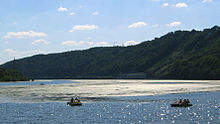
The Ruhr is a river in western Germany, a right tributary (east-side) of the Rhine.

The Sauerland is a rural, hilly area spreading across most of the south-eastern part of North Rhine-Westphalia, in parts heavily forested and, apart from the major valleys, sparsely inhabited.

The Ludington Pumped Storage Plant is a hydroelectric plant and reservoir in Ludington, Michigan. It was built between 1969 and 1973 at a cost of $315 million and is owned jointly by Consumers Energy and DTE Energy and operated by Consumers Energy. At the time of its construction, it was the largest pumped storage hydroelectric facility in the world.

Pumped-storage hydroelectricity (PSH), or pumped hydroelectric energy storage (PHES), is a type of hydroelectric energy storage used by electric power systems for load balancing. The method stores energy in the form of gravitational potential energy of water, pumped from a lower elevation reservoir to a higher elevation. Low-cost surplus off-peak electric power is typically used to run the pumps. During periods of high electrical demand, the stored water is released through turbines to produce electric power. Although the losses of the pumping process make the plant a net consumer of energy overall, the system increases revenue by selling more electricity during periods of peak demand, when electricity prices are highest. If the upper lake collects significant rainfall or is fed by a river then the plant may be a net energy producer in the manner of a traditional hydroelectric plant.

Hydroelectricity, or hydroelectric power, is electricity generated from hydropower. Hydropower supplies one sixth of the world's electricity, almost 4500 TWh in 2020, which is more than all other renewable sources combined and also more than nuclear power. Hydropower can provide large amounts of low-carbon electricity on demand, making it a key element for creating secure and clean electricity supply systems. A hydroelectric power station that has a dam and reservoir is a flexible source, since the amount of electricity produced can be increased or decreased in seconds or minutes in response to varying electricity demand. Once a hydroelectric complex is constructed, it produces no direct waste, and almost always emits considerably less greenhouse gas than fossil fuel-powered energy plants. However, when constructed in lowland rainforest areas, where part of the forest is inundated, substantial amounts of greenhouse gases may be emitted.

The Dinorwig Power Station, known locally as Electric Mountain, or Mynydd Gwefru, is a pumped-storage hydroelectric scheme, near Dinorwig, Llanberis in Snowdonia national park in Gwynedd, north Wales. The scheme can supply a maximum power of 1,728 MW (2,317,000 hp) and has a storage capacity of around 9.1 GWh (33 TJ).

Herdecke is a town in the district of Ennepe-Ruhr-Kreis, North Rhine-Westphalia in Germany. It is located south of Dortmund in the Ruhr Area. Its location between the two Ruhr reservoirs Hengsteysee and Harkortsee has earned it the nickname Die Stadt zwischen den Ruhrseen.

Bewl Water is a reservoir in the valley of the River Bewl, straddling the boundary between Kent and East Sussex in England. It is about 2 miles (3.2 km) south of Lamberhurst, Kent. The reservoir was part of a project to increase supplies of water in the area. It supplies Southern Water’s customers in the Medway towns, Thanet and Hastings.

Grid energy storage is a collection of methods used for energy storage on a large scale within an electrical power grid. Electrical energy is stored during times when electricity is plentiful and inexpensive or when demand is low, and later returned to the grid when demand is high, and electricity prices tend to be higher.
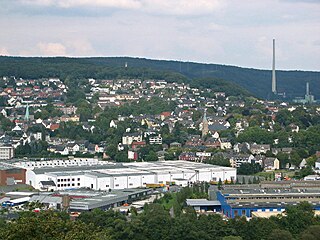
Wetter (Ruhr) is a town in western Germany, in the federal state of North Rhine-Westphalia and the district of Ennepe-Ruhr-Kreis. The river Ruhr flows through the urban area, separating the district of Alt-Wetter from the districts of Esborn, Volmarstein and Wengern. The cities of Dortmund and Bochum are within 20 minutes by road or rail.

A reservoir is an enlarged lake behind a dam. Such a dam may be either artificial, usually built to store fresh water, or it may be a natural formation.

The Los Reyunos Dam is an embankment dam on the Diamante River, in central Mendoza Province, Argentina, some twenty-two miles from the city of San Rafael. The dam, built of stone and compacted clay to minimize execution and cost, is 440 feet high and contains a reservoir covering an area of 1,828 acres (7.40 km2).

The Seneca Pumped Storage Generating Station is a hydroelectric power plant using pumped storage of water to generate electric power. It is located near Warren, Pennsylvania in Warren County.
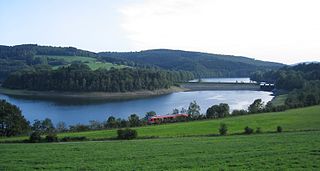
The Biggesee or Bigge Reservoir is a reservoir in Germany. It lies in the southern part of the Sauerland between Olpe and Attendorn.
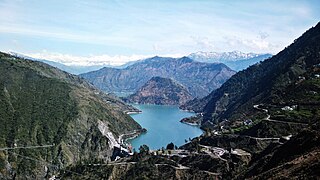
The Chamera Dam impounds the River Ravi and supports the hydroelectricity project in the region. It is located near the town of Dalhousie, in the Chamba district in the state of Himachal Pradesh in India. The reservoir of the dam is the Chamera Lake. Large part of its reservoir lies in Salooni sub-division of Chamba.

The Ruhr–Sieg railway is a 106 km long double-track, electrified main line from Hagen to Siegen via Iserlohn-Letmathe, Finnentrop and Kreuztal in the German state of North Rhine-Westphalia. The line, which has many tunnels, runs primarily through the valley of the Lenne. South of Altenhundem it crosses the watershed between the Lenne and the Sieg. The line was opened between 1859 and 1861 and is one of the oldest railways in Germany.
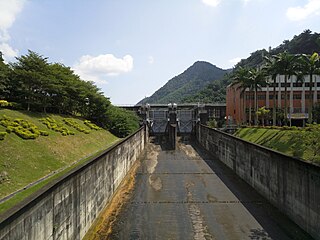
The Minghu Dam (Chinese: 明湖水壩; pinyin: Mínghú Shuǐbà, renamed the Takuan Dam, is a concrete gravity dam on the Shuili River located 7 km north of Shuili Township in Nantou County, Taiwan. The reservoir formed by the dam serves as the lower reservoir for the Minhu Pumped Storage Hydro Power Station. Sun Moon Lake serves as the upper reservoir.

The Linth–Limmern Power Stations are a system of hydroelectric power stations located south of Linthal in the canton of Glarus, Switzerland. The system uses five reservoirs and four power stations at steep variations in altitude.

The Żarnowiec Pumped Storage Power Station is a pumped-storage power station located about 7 km (4.3 mi) south of Żarnowiec, in Puck County, northern Poland. It was constructed between 1973 and 1983 and underwent a modernisation between 2007 and 2011, with the upper reservoir reconstructed in 2006.
The Steenbras Power Station, also Steenbras Hydro Pump Station, is a 180 MW pumped-storage hydroelectric power station commissioned in 1979 in South Africa. The power station sits between the Steenbras Upper Dam and a small lower reservoir on the mountainside below. It acts as an energy storage system, by storing water in the upper reservoir during off-peak hours and releasing that water to generate electricity during peak hours. The City of Cape Town uses the power station for load balancing and to mitigate against loadshedding caused by the South African energy crisis. This power station is reported to be the first pumped-storage hydroelectric power station to be built on the African continent.

